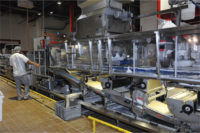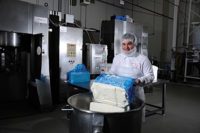Snak King has added a second snack production location, its recently acquired Vitner’s plant. Expanded to 220,000 sq. ft., the facility in Freeport, Ill., has been redesigned and upgraded to meet the company’s high standards. Outfitted with seven production lines, 300 employees and 31 packaging machines, the plant has what it takes to focus on new initiatives with improved efficiency and greater capacity.
Snak King, City of Industry, Calif., is in the process of upgrading its recently acquired, 220,000-sq.-ft. snack production facility in Freeport, Ill., to meet its high standards. Located in Freeport, Ill., the plant joins the company’s main production plant in City of Industry, Calif., to produce hundreds of stock-keeping units (SKUs), including potato chips, popcorn, tortilla and veggie chips, pork rinds, nuts and trail mixes, cheese puffs and cheese curls.
While Snak King’s two plants don’t produce exactly the same products between them, overall, they generate enough base product to make an incredible 700 SKUs. “A lot of these SKUs are based on 300 recipes that go into different package sizes and configurations,” explains Mark Schieldge, the company’s vice president of quality and innovation, who spearheaded the improvement projects in Freeport. Nestled on about 50 acres, the former C.J. Vitners Co. manufacturing facility is approximately 100 miles northwest of Chicago.
When Snak King purchased the plant, it included a 137,000-sq.-ft. production space, a potato “kitchen” and a corn “kitchen” that perform the processing work. “Starting last November, we began adding more than 83,000 sq. ft. to the facility, which includes a large warehouse for finished goods as well as some new packaging equipment, the tortilla line and some new ovens,” says Schieldge.
The extra warehouse space, which is an ample 45 ft. tall, will come in handy: The plant goes through about just under 1 million pounds of potatoes a week. Total pounds of finished product per week are also about 1 million. All of the snacks are made to-order on a just-in-time basis and ship within a week, Schieldge says.
Outfitted with seven production lines, 300 employees and 31 packaging machines, the Freeport plant now has what it takes to focus on Snak King’s latest initiatives with improved efficiency, top quality and greater capacity. The plant enhancements began late in 2012.
“We removed a lot of old packaging equipment and installed new equipment in August, which is when we commissioned a new tortilla chip line,” says Schieldge as he guided Snack Food & Wholesale Bakery on a tour of the facility, which, at the time, was running potato chip thins under the Vitners brand and private labels.
“We have a lot of changeovers here because we run so many different recipes,” he says. There can often be as many as 20 to 50 flavor changes a day across all of the lines, and the equipment must be cleaned depending on what allergens and organic or nonorganic products are involved, he explains. This takes two or three hours for a complete washdown and about 30 minutes if a line is changing from one like allergen to another.
Potatoes aplenty
On the day of our visit, steam rising from the plant carried the scent of fresh potatoes over the entire area for miles. Production runs three eight-hour shifts, five days a week. “On the other two days, we perform detailed maintenance and sanitation,” Schieldge explains. “We have Hazardous Analysis Critical Control Points [HACCP] throughout the plant, and on this line, which use metal detection as our CPP.”
Most of the snack lines operate under a similar sequence of events. To make the thin potato chips, for example, potato deliveries arrive around the clock. Vegetable oil is delivered by tanker trucks, and the potatoes are also trucked to the plant each week. Only the best-quality potatoes will do to make Snak King’s products. All incoming ingredients, including potatoes, oils, and corn are weighed on a truck scale outside of the main drive to the building. The ingredients are tested and monitored regularly by the U.S. Department of Agriculture (USDA) for accuracy.
A large truck dumper delivers the loads of potatoes, which can come from Illinois and Michigan or as far south as Florida, depending on the season and growing conditions. Schieldge says the potatoes come to the plant (based on production scheduling) about every four hours. Each truck holds about 45,000 lb. of potatoes.
“We get potatoes from various regions of the country, depending on what time of year it is,” Schieldge explains. “They’re grown throughout the U.S., but we harvest them during the prime growing season in which those states can provide them. In the winter, the whole potatoes are put in storage after harvesting and the growers will maintain them with the proper environmental conditions. Then in April, we’ll get the fresh spring crop harvested directly out of the ground to process.”
Other bulk ingredients, such as various kinds of oil, are piped into the facility’s series of holding tanks or are transferred to a five-rack-high, raw goods/packaging materials storage area in large sacks. Allergens have designated storages areas and are separated by type to minimize any potential cross-contamination. Disclaimers for allergens and organic materials are included for all incoming ingredients.
Peeling and slicing
On a typical potato chip line like the one SF&WB viewed, fresh potatoes automatically convey from the truck outside into the facility, where they are unloaded and augers pull the potatoes into large processing bins from which they will be made into potato chips. They then convey through a flume system that removes contaminants and are washed and transported by conveyor to a peeling system. They’re also inspected by an operator who cuts away any imperfections before they elevate to the peeler and into another room that houses a slicer. The edible waste is collected and sent to farms for use as feed.
Alongside the bins are the oil storage tanks, which hold a full truckload of various types of oil. The dual-head slicers use centrifugal force to push the potatoes against sharp blades to make super-thin slices. Next, the slices move on to the potato kitchen and a fryer. A continuous stream of potatoes is processed daily. The fryer “cooks” the slices at an average temperature of 340 to 365 deg. F. The fried chips emerge and deposit onto a wide conveyor belt to cool and shuttle onto narrower vibratory tracks that separate them before they’re electronically scanned for defects or dark spots.
Sensors constantly monitor moisture levels and oil contents in the chips. The chips also pass through a metal detector to ensure that no outside contaminants get into the product, as well as through a rapid defect inspection system. The line runs at about 400 ft. per minute.
The finished chips then transfer to a salter and to a series of vibratory conveyors that spread them apart to cool and pass through a contamination inspection system. An air blast removes defective chips out of the product stream. The chips are then elevated on a bucket conveyor that carries them to a mezzanine level.
They subsequently drop onto another vibratory conveyor in the large packaging room and are immediately seasoned with various flavors (depending on product variety) when they enter one of several on-machine seasoning tumblers. The rotating tumblers can run as many as seven different flavors at one time.
“On-machine seasoning is what is considered state of the art for potato chips,” Schieldge says. “We can run generally four or five flavors at a time and a couple of unsalted products.”
Next, the seasoned chips are electronically weighed on the scales above a set of vertical form/fill/seal baggers. They first deposit into the weigh buckets on one of seven weigher systems. The weighers each have side-by-side bucket systems, with eight buckets per side.
The scales automatically choose the right weight combination to drop into the bags being formed from rollstock on the main floor below. The seasoned chips then drop through a chute to one of seven form/fill/seal bagging lines on the main packaging floor below. Metal detectors on each bagmaker check for any contaminants.
“The new seasoners and weigher/baggers were part of our upgrade last year,” Schieldge says.
Inspections
At various stations throughout the process, product quality is inspected. A Quality Assurance lab on one side of the room also checks product factors such as appearance, oil stability, seasoning coverage and the weight of the finished product. Debbie Block, a quality control lab technician, explains that she also looks at the inner and outer edges of the chips and hunts for clusters of chips and other defects, making an audit report on an hourly basis. If Block starts to find more defects, she instructs the line operators to speed up the defect-sensing system.
The film rollstock for the chip bags is stored in a climate-controlled room in a nearby warehouse that maintains rollstock for all of the SKUs.
Case-packing operators receive the bags that exit the baggers, inspecting the bags as they erect and loading them into corrugated shipping cases. The cases are then tape-sealed semi-automatically, and operators load pallets with the filled, sealed cases, before the loads are stretch-wrapped automatically in clear stretch film for shipment. Rows and rows of the cased snacks are kept in a warehouse, waiting to be loaded onto outbound trucks.
Many of the products made at Freeport are distributed to the Chicago area via truck routes handled by multiple distribution centers (DCs), Schieldge says. The majority of those shipments are sent directly from Freeport to the DCs. The routes don’t originate from here—they all run from the DCs.
Computerization governs all raw materials and packaging, which are tracked with bar-coded license plate labels that are frequently scanned at different stages of the production cycle. This affords real-time checks and adjustments of inventory, warehousing, shipments, receipt and other supply-chain conditions.
Saving energy
The plant recycles the majority of its food and container waste, Schieldge says, and is presently developing ways to cut its utilities usage. “In California, we’re working with the gas company to identify ways to reduce our gasload, and explore different energy-saving ideas,” he says.
“We have a tremendous amount of heat that comes off of the ovens and fryers. We want to try to capture that and leverage it. Wind generation might be a practical option.”
From the looks of the busy Freeport facility, Snak King is relatively immune to today’s difficult economy, Schieldge notes. “Generally, when the economy is soft, people stay home and treat themselves to something nice, like snacks. So we haven’t really suffered too much in this economy.”
Future projects
What’s on the horizon for this royal snack plant? “This month, we’re opening our new warehouse,” Schieldge says. “Also later this year, we’re going to realign our extrusion departments and rearrange some of our extruder lines. Long-term, we plan to add more production lines.”
In addition, a pressure-popped crisp production line is going through a shakedown in Snak King’s California location. If the popped products do well in the market, such a line may be added in Freeport, Schieldge says.
There are several things in the works he says he can’t yet discuss, but they certainly fall into the innovation category. “We’re already looking at ways to expand the popped-crisps line’s production and potentially bring that [product production] here, too,” he says. “New niches are a real key for us. The ability to be nimble, efficient and have the flexibility to roll out new products are always important.”
In fact, Schieldge points out that one of Snak King’s greatest strengths is its senior management team. “The group really works together really well,” he says. “The synergy among management here is so vital because it allows us to develop really strong teams. We’re not a big company, so we have small engineering and R&D teams, but the people here are really efficient.”
If his boundless energy is an indication of the output the company generates, there’s no telling what Snak King could do next. One move it made last year was to introduce more than 100 different products that are all doing well on the market, Schieldge says.
“I’m proud of so many different things here,” he sums up. “One hundred new products is quite an accomplishment. I’m also proud of the commitment we have at this facility, of this plant’s integration within the company and the investment in our new systems here. I think that’s what drives us and makes us successful.”













